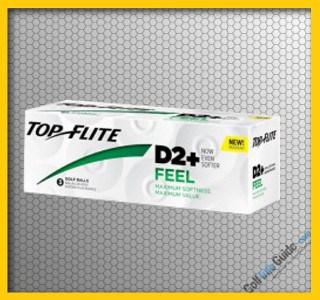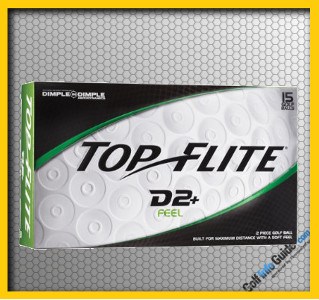
Ball tested: Top-Flite D2+ Feel
Category: Value/Recreational/Distance
Feel: Soft
Tested for golfers with average driving distance of: 125 yards or less (carry + roll) / 126 to 195 yards (carry + roll) / 196 to 245 (carry + roll)
Specs: Construction – Two-piece; Cover – Ionomer; Core – Polybutadiene; Dimples / Pattern – 332 in “Dimple in Dimple” design
Compression: Low
Price as tested (new): $15.99 per package of 15
Ball notes: It takes guts to tout a two-piece, ionomer-covered ball for its feel – especially if your brand was once associated with products so hard they were often compared to cue ball – so credit Top-Flite for going where other companies fear to tread. ( Wilson being a notable exception.) The D2+ Feel aims at golfers who want maximum distance at a low price, in a softer package than standard “distance” balls usually offer.

The D2+ lineup also includes the Distance and Straight models, which appeal to those with slightly different preferences. The Feel version features the lowest core compression and softest cover of the trio. There’s a women’s version as well, the D2+ Diva.
Is Feel an accurate term, or a misnomer tacked on by the marketing folks? Read on for our opinion.
On the clubface: By testing the D2+ Feel simultaneously with its sibling models, we were able to compare the three balls directly in each category. That made it easy to tell the Feel version is, indeed, considerably softer than its counterparts. This carried throughout the bag, no exceptions, driver to putter. Not only did the Feel stack up well against its own kind, we’d rank it alongside “premium” balls from Titleist, Bridgestone and other big-name manufacturers.
Off the tee: Frankly, the D2+ Feel caught us off guard here. We expected the ball to come up a little short vs. the Distance and Straight models, but it proved every bit as long. The medium-high trajectory and accurate, unwavering flight were right there with the others, too.

From the fairway / rough: Having been pleasantly surprised by the Feel’s driving performance, we were primed for a letdown in the approach game. But guess what? The ball acquitted itself quite well with the irons. It’s a far cry from “tour” models for spin and workability, but competitive with any value ball we’ve tried. You can actually count on well-struck iron shots stopping pretty abruptly, especially the wedges.
Around the green: We’re admittedly partial to multi-layered, urethane golf balls for greenside control, but the D2+ Feel provided enough spin and versatility to leave most two-piece, firm-cover models in the dust. The low compression gives it a fine “thump” off the putter blade as well.
Bottom line: All things being equal, we’d choose the D2+ Feel as our favorite of this Top-Flite series. Judged against its peers, the ball provided similar results with the driver and superior performance from fairway to cup. Not to dismiss the Distance and Straight versions, but Feel offers everything they do and then some – at the exact same price.
Golf Ball Videos:
– Compression Video
– Spin Video
– Dimples Video
– Golf Ball Brands Video
– Titleist Video
– Understanding Spin Video
Categories Explained:
Value/Recreational/Distance – Designed for mid- to high-handicap golfers with swing speeds below 90 mph; typically feature two-piece construction and firm covers; promote greater distance over high spin rates. Examples: Pinnacle Gold, Slazenger RAW Distance
Premium – Designed for low- to mid-handicap golfers with swing speeds of 90-99 mph; typically feature multi-layer construction and medium-soft covers; happy medium between Value/Recreational and Tour categories for distance and spin qualities. Examples: Titleist NXT Tour, Callaway HEX Diablo
Tour/Advanced/Performance – Designed for low-handicap and professional golfers with swing speeds in excess of 100 mph; typically feature multi-layer construction and soft covers; promote greater spin rates and enhanced feel over distance. Examples: Titleist ProV1, Bridgestone Tour B330





